#TurboGrafix-16
Explore tagged Tumblr posts
Text




Bubblegum Crash! 1991 TurboGrafix-16/PC Engine
#retro gaming#gaming#video games#acquired stardust#bubblegum crisis#bubblegum crash#pixel art#anime#retro anime#80s anime#90s anime#priss asagiri#linna yamazaki#nene romanova#sylia stingray#gifs#pc engine#turbografx#turbografix 16#tg16#nostalgia#90s#1990s#gif#game gifs#cyberpunk#aesthetic#oldtaku#classic anime#old school anime
588 notes
·
View notes
Text
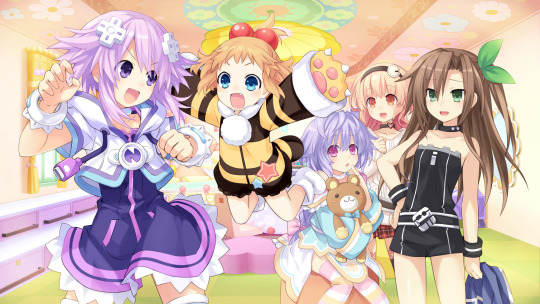
#Neptunia franchise#Animations and Videogames#IF#Personifications#Ideal Factory#Neptune#Planeptune#Goddess#Purple Heart#Fictional version of Sega console#PC Engine (Turbografix-16)#Peashy#Sega consoles#Plutia#Iris Heart#Compa#Humans#Goddesses
3 notes
·
View notes
Text


Peashy
2 notes
·
View notes
Text
Bishoujo Senshi Sailor Moon PC Engine/Turbografix 16 Game Playthroughs
Finally complete! Playthrough and reaction streams of the very rare Turbografx 16/ NES PC Engine Game Bishoujo Senshi Sailor Moon from 1994. It takes place after the Maijaku Arc (the Doom Tree Arc) and is in visual novel format, recorded with the original Japanese voice actors from the 90s anime. It is an addendum to the Dark Kingdom Arc of the 90s anime, closing out the loose ends. This is the fan-translated English version.

Multistreamed on Discord and Piczel.tv for five nights, one for each character. Done in podcast style (meaning you’ll hear our voices and all our corny jokes) Final stream is in two parts and has never-before-seen cut scenes that were not included in the game.
(WARNING: TALK CAN GET NSFW)
#bishoujo senshi sailor moon#sailor moon#senshi x shitennou#sailor moon video game#visual novel#turbografx 16#pc engine#YouTube streams
19 notes
·
View notes
Text
More of a unique shmup is up next. Atomic Robo-Kid

This one, I see the vision, but it is a bit stiff for my liking. I've heard the PC Engine/Turbografixs-16 version is better so I am curious to try it when I get to that system. I do think the pacing of the game is fine just the game feels a bit stiff to play.
2 notes
·
View notes
Text
Hell is terms like ASIC, FPGA, and PPU
I haven't been doing any public updates on this for a bit, but I am still working on this bizarre rabbit hole quest of designing my own (probably) 16-bit game console. The controller is maybe done now, on a design level. Like I have parts for everything sourced and a layout for the internal PCB. I don't have a fully tested working prototype yet because I am in the middle of a huge financial crisis and don't have the cash laying around to send out to have boards printed and start rapidly iterating design on the 3D printed bits (housing the scroll wheel is going to be a little tricky). I should really spend my creative energy focusing on software development for a nice little demo ROM (or like, short term projects to earn money I desperately need) but my brain's kinda stuck in circuitry gear so I'm thinking more about what's going into the actual console itself. This may get techie.
So... in the broadest sense, and I think I've mentioned this before, I want to make this a 16-bit system (which is a term with a pretty murky definition), maybe 32-bit? And since I'm going to all this trouble I want to give my project here a little something extra the consoles from that era didn't have. And at the same time, I'd like to be able to act as a bridge for the sort of weirdos who are currently actively making new games for those systems to start working on this, on a level of "if you would do this on this console with this code, here's how you would do it on mine." This makes for a hell of a lot of research on my end, but trust me, it gets worse!
So let's talk about the main strengths of the 2D game consoles everyone knows and loves. Oh and just now while looking for some visual aids maybe I stumbled across this site, which is actually great as a sort of mid-level overview of all this stuff. Short version though-
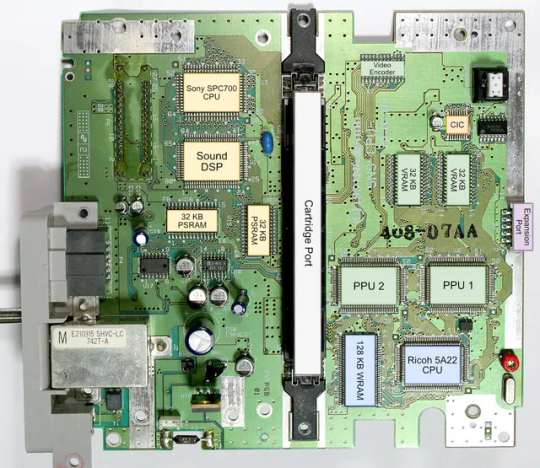
The SNES (or Super Famicom) does what it does by way of a combination of really going all in on direct memory access, and particularly having a dedicated setup for doing so between scanlines, coupled with a bunch of dedicated graphical modes specialized for different use cases, and you know, that you can switch between partway through drawing a screen. And of course the feature everyone knows and loves where you can have one polygon and do all sorts of fun things with it.
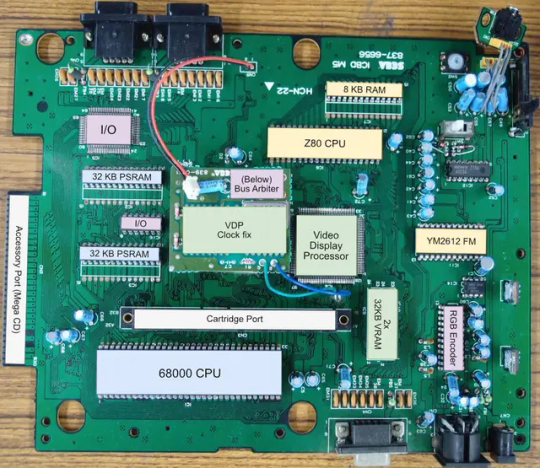
The Genesis (or Megadrive) has an actual proper 16-bit processor instead of this weird upgraded 6502 like the SNES had for a scrapped backwards compatibility plan. It also had this frankly wacky design where they just kinda took the guts out of a Sega Master System and had them off to the side as a segregated system whose only real job is managing the sound chip, one of those good good Yamaha synths with that real distinct sound... oh and they also actually did have a backwards compatibility deal that just kinda used the audio side to emulate an SMS, basically.
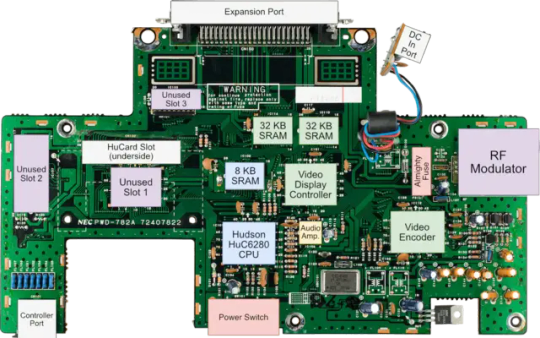
The TurboGrafix-16 (or PC Engine) really just kinda went all-in on making its own custom CPU from scratch which...we'll get to that, and otherwise uh... it had some interesting stuff going on sound wise? I feel like the main thing it had going was getting in on CDs early but I'm not messing with optical drives and they're no longer a really great storage option anyway.
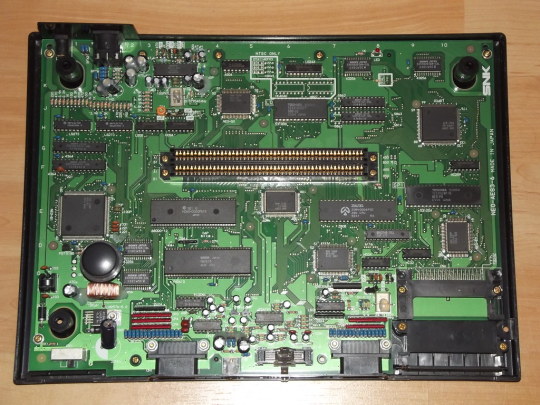
Then there's the Neo Geo... where what's going on under the good is just kind of A LOT. I don't have the same handy analysis ready to go on this one, but my understanding is it didn't really go in for a lot of nice streamlining tricks and just kinda powered through. Like it has no separation of background layers and sprites. It's just all sprites. Shove those raw numbers.
So what's the best of all worlds option here? I'd like to go with one of them nice speedy Motorolla processors. The 68000 the Genesis used is no longer manufactured though. The closest still-in-production equivalent would be the 68SEC000 family. Seems like they go for about $15 a pop, have a full 32-bit bus, low voltage, some support clock speeds like... three times what the Genesis did. It's overkill, but should remove any concerns I have about having a way higher resolution than the systems I'm jumping off from. I can also easily throw in some beefy RAM chips where I need.
I was also planning to just directly replicate the Genesis sound setup, weird as it is, but hit the slight hiccup that the Z80 was JUST discontinued, like a month or two ago. Pretty sure someone already has a clone of it, might use that.
Here's where everything comes to a screeching halt though. While the makers of all these systems were making contracts for custom processors to add a couple extra features in that I should be able to work around by just using newer descendant chips that have that built in, there really just is no off the shelf PPU that I'm aware of. EVERYONE back in the day had some custom ASIC (application-specific integrated circuit) chip made to assemble every frame of video before throwing it at the TV. Especially the SNES, with all its modes changing the logic there and the HDMA getting all up in those mode 7 effects. Which are again, something I definitely want to replicate here.
So one option here is... I design and order my own ASIC chips. I can probably just fit the entire system in one even? This however comes with two big problems. It's pricy. Real pricy. Don't think it's really practical if I'm not ordering in bulk and this is a project I assume has a really niche audience. Also, I mean, if I'm custom ordering a chip, I can't really rationalize having stuff I could cram in there for free sitting outside as separate costly chips, and hell, if it's all gonna be in one package I'm no longer making this an educational electronics kit/console, so I may as well just emulate the whole thing on like a raspberry pi for a tenth of the cost or something.
The other option is... I commit to even more work, and find a way to reverse engineer all the functionality I want out with some big array of custom ROMs and placeholder RAM and just kinda have my own multi-chip homebrew co-processors? Still PROBABLY cheaper than the ASIC solution and I guess not really making more research work for myself. It's just going to make for a bigger/more crowded motherboard or something.
Oh and I'm now looking at a 5V processor and making controllers compatible with a 10V system so I need to double check that all the components in those don't really care that much and maybe adjust things.
And then there's also FPGAs (field programmable gate arrays). Even more expensive than an ASIC, but the advantage is it's sort of a chip emulator and you can reflash it with something else. So if you're specifically in the MiSTer scene, I just host a file somewhere and you make the one you already have pretend to be this system. So... good news for those people but I still need to actually build something here.
So... yeah that's where all this stands right now. I admit I'm in way way over my head, but I should get somewhere eventually?
11 notes
·
View notes
Text
Completed: Ys I: Ancient Ys Vanished
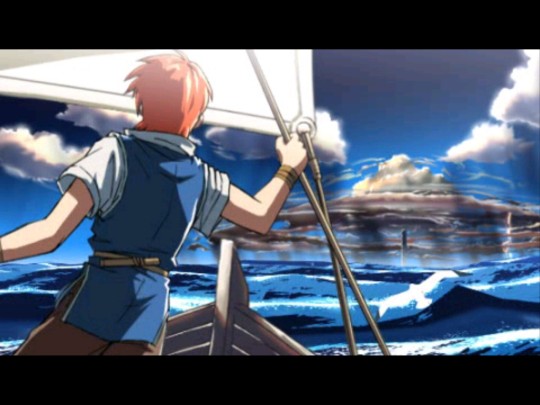
Place your bets on how many times I mention the words "Zelda" and "salmon" in this evaluation.
One term may be self-explanatory. The other…you'll find out.
I think I've been exposed to a fair amount of video games. If I've beaten hundreds of games, it's only because I've played thousands. What's limited my ability to fully experience as many video games as possible? Well, time and money are obvious restrictions. I'd put my nationality as a strong third contender. Which, yes, you're allowed to call bullshit on that, what with my nationality being American and all. I didn't have to go through half of the shit that someone from Brazil, Poland, or Russia had to just to play a damn video game. But, my tastes are Japanese, tainted Nintendo-red from the recovery of the home console market in the 1980s. Even with as much cultural and fiscal exchange that goes on between Japan and the United States, there are still going to be keystones and touchpoints that I am going to miss. Influences, spectral as they are, that I want to discover.
The "Ys" series is one such case.
I don't have sales figures for "Ys I: Ancient Ys Vanished." I can't definitively say that this series has influenced dozens of video games that I have enjoyed. What I can do is point at certain scenes within the game and go, "Shit, Nintendo ripped this part off in "The Legend of Zelda: A Link to the Past."" The amounts of ports this title has received over the years may also be a good indicator that "Ys I" was a darling of the 1980s Japanese home computer market. The PC-88 seemed like a good home for the title, but it damn well didn't stay there. Hopping to the MSX2, MS-DOS, X68000, TurboGrafix-16, Sega Master System, Nintendo Famicom, PlayStation Portable, and the gosh darn Steam market is testament to just how far this game has gone over the years. Hell, that's not even half of the consoles and computers this game has turned up on. It's a Blanche Devereaux of video games—old, present in more places you think, and enjoyed by a surprising amount of people.
"Ys I" (and the series at large) stars Adol Christin, a man driven by a salmon-like instinct to dive face-first into danger the first chance he gets. Such reckless behavior leaves him shipwrecked on an island after managing to plow through a wall of storms that has killed everyone else that has dared to cross it. (You are free to check off "Link's Awakening" from your "Potential Zelda Games Ys Influenced" bingo card.) After recovering from his little escapade, Adol plunges head-first again into the troubles of the island, seeking the goddesses that seemingly have left the island abandoned, as well as six tomes containing the great knowledge and destruction of the mighty civilization Ys that fell long ago. Who else seeks these tomes? Where are all of these demons coming from? Why does this island have so many blue-haired chicks, and why does Steam want to give me three achievements for harassing one of them?
Look, I don't think the original game was designed by delinquent perverts. Whoever made the achievement list might have been, though.
As you may suspect, a lot of how I understand "Ys I"'s design is through my understanding of "The Legend of Zelda" and its subsequent games. Is that a fair comparison to make? Well, they are roughly the same age, one being published in 1986 and the other in 1987. Different systems, sure. Same environment. It's not like "The Legend of Zelda" is the be-all, end-all of top-down fantasy action games. But, more games of this build are likely to emulate "Zelda" than "Ys," even when I talk about "Ys" being an influential younger sibling plot-wise to the former's later titles. If we want to be a bit more diverse, we can throw "Hydlide" into the mix. But, there's always a danger with having an American talk about "Hydlide." Especially, if they don't put that game's age into context!
Look, it's way fairer to compare games from 1986 and 1987 than games from 1984 and 1987. Three years of difference then is like decades of difference now. People and technology evolved that fast. The Japanese economy and Moore's law were amazing like that.
Because I am familiar with the "Zelda" game style, "Ys I" was initially difficult for me. (Okay, it was extremely difficult at two specific points later in the game, but let's just start with the initial play style.) See, one important design detail about "The Legend of Zelda" is that its main hero is left-handed. This helps a player center their shots, often putting them square with their foes. Adol, as you may have guessed, is not Link. Adol is a "Dungeons and Dragons" rogue in a weapon and armor set that should be way too heavy for him. His modus operandi is to crash into an enemy's back or sides, slamming in that flanking bonus for all its worth. He is not a salmon jumping into a bear's mouth (although, I suppose he is that narratively.) He is a salmon plinking off the side of a bear until it inexplicably explodes.
This style of fighting can feel messy to a "Zelda" veteran. It's not something that can't be overcome, but it does require some study. However, it does feel more natural than the "hold A to go offensive / release A to defend yourself" situation that "Hydlide" had going on. At least, a person is way more likely to figure out "Ys I" naturally than they would "Hydlide." I guess playing "Ys I" after "The Legend of Zelda" is a bit like learning how to drive a car with a manual stick, then being given an automatic car. Like, sure, the automatic is simpler. But, if you're used to taking control, you'll feel uncomfortable having that control removed from you. At least, a bit on ice.
I don't know how "Hydlide" fits into that analogy. Maybe it's like going from a manual car to a car that operates on "Red Light Green Light" rules, but you don't figure that out before crashing it into an electrical pole.
Don't expect much in terms of combat evolution with "Ys I." The tools that Adol gets are meant more for hocking or trespassing than any changes in how you attack. There's no bow or boomerang to give him some range. If you get a weapon, it's just another sword with more power. Nothing much outside of a little numerical boost. (Okay, a power bonus, and actually allowing damage on two bosses, but we'll…we'll get to those damn bosses.)
Everything comes down to you hauling ass into combat, then tearing Adol's ass back out. The poor boy has almost no invincibility frames to speak of, so it's very easy to make silver sashimi out of him if you aren't careful. While he does have some automatic health recovery, it requires him to be still and either in an open area or using a particular ring that you get later in the game. Sure, you can pop a healing potion from time to time. Just maybe not when you'd need it, like in a damn boss fight!
Seriously, man. What's up with that? Do you need to set out the fine china before you can take a sippy, Adol? That's very un-salmon-like behavior of you.
Because so much of the combat revolves around this hit-and-run style of swordplay, a lot of the boss design and tactics will devolve into "run at that guy the first chance you get" and "run in circles until you can stab that guy." About the only major curveball the game throws at you with this is requiring silver equipment for precisely two bosses. These bosses are also infuriating in the "Ys I" variant I played. Like, I easily spent 20-30 minutes killing a boss that only takes a minute to kill when done correctly. It's never a good sign when you open up an FAQ only for it to go "LOL, good luck." It got to the point where I had to mute the game just so that I would stop getting distracted by the awesome music. That's what these bosses did to me. They drove me into committing audio felonies.
Now, this boss issue is something I lay at the feet of the designers for the "Ys I" variant I played (the Chronicles+ Steam port.) See, when I look at PC-88 footage for these bosses, I don't see the particle hell that I had to endure. Even other ports aren't as aggressive as the Chronicles+ version. I don't know if someone had bullet hell brain rot or wanted to throw as many projectiles on screen as possible just for a computational flex, but man, was it aggravating.
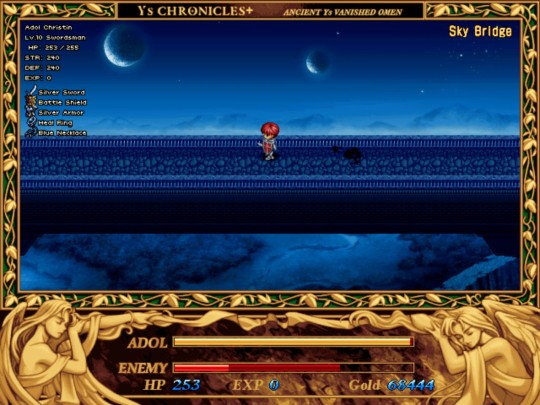
If everything about "Ys I" was as frustrating and repulsive as those bosses, the game wouldn't have survived past its inaugural entry. Lucky for it, the game has a lot of things going for it aesthetically. The game puts a great deal of effort into its character portraits and sprite work, blending top-down action with full portraits like something out of a visual novel. It can be a remarkably peaceful game to look at. Like, I did end up taking breaks while digging through an abandoned mine or a massive tower's annex just to admire what little sunlight came down upon gently swaying bridges. The Chronicles+ version is at least pretty. I'll give it that! Even the original release has its charms with its sprite work. Frankly, I think the main screen and final boss portraits look better in the PC-88 version, if for nothing else than for the feelings of imaginary nostalgia and subtle chills I get looking at them.
While "Ys I" doesn't have the most complex plot in the world, it was certainly leaps and bounds ahead of most games from the 1980s. The game puts a great amount of effort into its NPCs, giving several their own portrait artwork and side quests. Hell, in the Chronicles+ version, you even get an achievement for talking to everybody. While never being fully conclusive on the exact nitty-gritty of Ys' fall, it's clear to understand what has happened to this place, as well as its goddesses. There are a lot of games that run Shintoism through European trappings, sure. Multitudes of goddesses, talking to sacred trees, sometimes getting swords out of them—I can think of at least two "Zelda"s and two "Tales" RPGs that work with the same tropes. However, this was one of the first games to do this, and it did it very well. There were at least two twists that I didn't see coming, one of which was quite shocking. Half of it was me not assuming that all brunets are related, sure. The other half? Well, let's just say I got more of a response out of it than when a certain "Final Fantasy" character got notoriously shafted.
The best quality of "Ys I", by far, is its soundtrack. I'm not kidding when I say this is how I was originally exposed to the game. A lot of what I listen to while working is video game soundtracks from the 1980s and 1990s. When this came up in my recommendations, I definitely took note of it. When it's not being eerie and mystical, it's driving with that sort of intensity rarely seen outside of late 80s/early 90s Japanese rock. If you are a synth fan, you owe it to yourself to listen to it. At least, give it three and a half minutes.
Hell, if you need a professional recommendation: former Capcom sound designer and current music professor / bird aficionado Hideaki Utsumi owns at least two variants of this game. I would imagine he would be much better at articulating how awesome this soundtrack and its programming is than I would.
As an additional note—one of the original composers for this game (Yuzo Koshiro) went on to make his own audio company, as well as contributed to a crapton of additional video games. (Not that Mieko Ishikawa is a slouch! She's holding the "Ys" series and other Nihon Falcom titles down just fine.) The particular interest I have with Mr. Koshiro is his contributions to "Castlevania: Portrait of Ruin." Like, yeah, the "Kid Icarus Uprising" stuff is mildly interesting, and anyone who is anyone in the Japanese video game music industry has ended up in a "Super Smash Bros." soundtrack at some point. But, ya know. I might like "Castlevania" a little bit. I could easily see his work slotting right into that series. (Or, hear, I guess.) Frankly, I'm surprised he wasn't called in to do more.
And, hey—if you're looking for more soundtracks that the pair worked on, check out "Sorcerian." Really confuse your YouTube recommendations. (Unless you're already on whatever pulse wave I'm already surfing, I guess! Then, I'm certain it's easy for us to shoot soundtracks we've both already heard to each other.)
I am curious about the limited amount of animation used by the Chronicles+ version of "Ys I." Originally, the animated intro was what made me think this game was based on a re-release set on the first PlayStation console. (I suppose it could have been a PlayStation 2 re-release as well.) It's a lovely intro! I dig it. I just don't know why the ending didn't have that quality to match it. I mean, I guess a still image was all the original "Ys I" had as well. It just feels weird to not have that same effort extended to the ending—especially, after all the effort I put into getting to it.
Maybe the "Ys II" ending has a bit more going on with it.
I may have one or two ways to find that out…
I'm left in a weird place with "Ys I." It was mostly a good experience, but when it was bad, it was godawful. I can't imagine most modern gamers would have the patience or undead ego it requires to beat either of the bastard bosses I mentioned before. It's only 9 hours if you're going in raw, but man, will you come out raw in at least one of those hours. If you need a test of your ability to overcome absolute bullshit, then I guess you can give the Steam version a try. Honestly? I'm more prone to recommend an older version, even without my having played the older versions. The PC-88 version at least looks like something an average human could have beaten. At least, something that would have become a mind worm to the general development of games that followed in its wake. The Chronicles+ version…man, I don't know. At least don't pay full price for that. Especially not when my recommended solution would be…let's just say, not using any silver. Running black flags to ruin magical black capes.
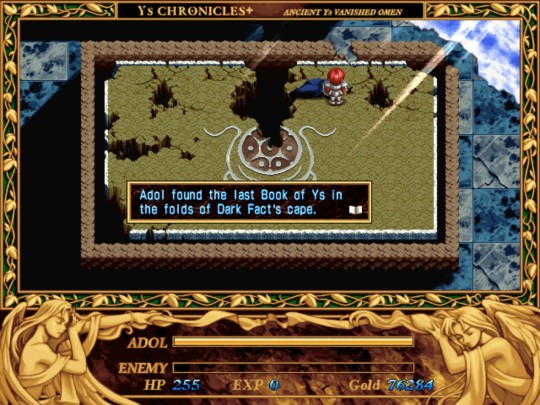
Honestly, Adol should have just jacked that cape like Dorothy Gale and the Ruby and/or Silver Slippers. Clearly, its previous owner isn't getting any more use out of it. Might have been a pain in the ass to wash out and mend after the stupid sword fight, though.
1 note
·
View note
Text
Devil's Crush for the TurboGrafix 16 confirmed best video pinball right? I mean cmon?
2 notes
·
View notes
Text
If I see a soul even pleasantly surprised that the Separate Ways campaign in RE4 Remake is free I will know that we have slipped too far and become a true emulation freak. I will just shun new video games forever. Become really obsessed with the TurboGrafix-16 or something.
1 note
·
View note
Text

Bubblegum Crash! 1991 TurboGrafix-16/PC Engine
#retro gaming#gaming#video games#bubblegum crisis#bubblegum crash#pixel art#anime#retro anime#80s anime#90s anime#priss asagiri#linna yamazaki#nene romanova#sylia stingray#gifs#pc engine#turbografx#turbografix 16#tg16#nostalgia#90s#old anime#oldtaku#1990s#1991#retro games#animanga#bgc
261 notes
·
View notes
Photo

When shit is about to go down on the PC Engine/TurboGrafix-16. Transition is used in all the PC Engine Fire Pro games.
1 note
·
View note
Photo
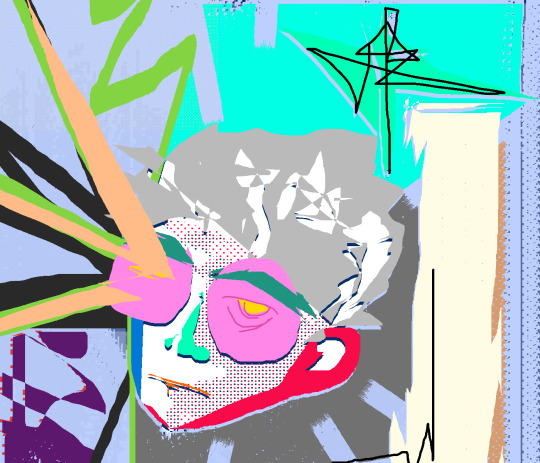
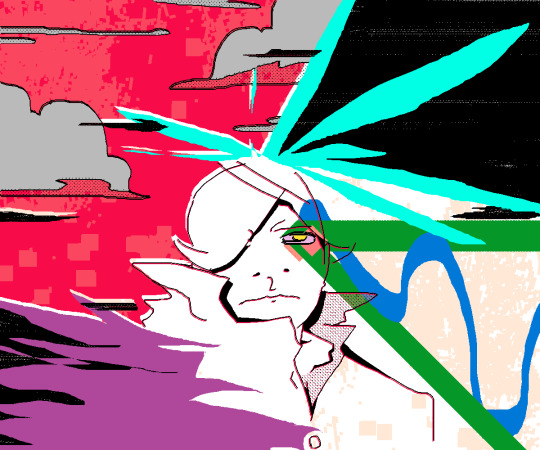
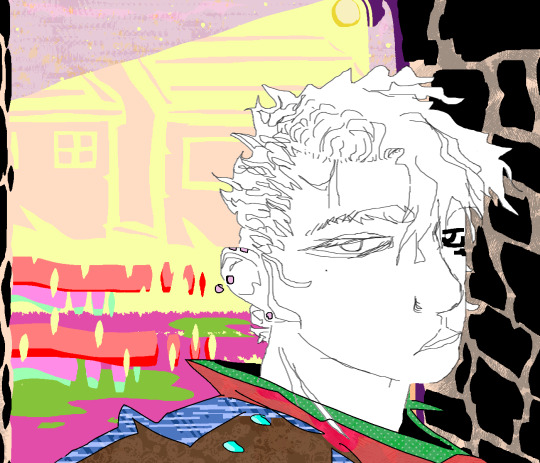
first post of the year, and also first post in months.
i stopped drawing for a while to finish up my school semester. but here’s some stuff i was working on in the meantime. i finished them up recently once i had some time again.
as always, i was trying something new. felt like i had a fun time doing so.
i think i’ve resigned myself to not knowing when another post will come together. as i don’t know when i’ll finish anything anymore.
hope i’m better next time.
#i can't believe it's almost february#2021 just started and i haven't done anything#dagnab#the first drawing i was basing off of something i'd find on a wall while walking down the street#the second drawing i based off of hanafuda cards#the last one i based off of the box art of a turbografix-16 game i saw and also an artist that i saw on twitter#i can't remember either names.#the first drawing is something of a self portrait
0 notes
Photo

I’ve been playing video games ever since the first Atari console came out. Went on to own SEGA, PlayStation, XBox, Turbografix 16, platforms etc but after 41 years I never owned a Nintendo and I have never played a Zelda game in my entire life. Until now. 🗡🧝♀️👍🏼 https://www.instagram.com/p/CQb3w5unTVY/?utm_medium=tumblr
3 notes
·
View notes
Video
youtube
The games that will be included on the TurboGrafix-16 Mini have officially been revealed! Watch the video above or check the list below.
American games:
Air Zonk
Alien Crush
Blazing Lazers
Bomberman ‘93
Bonk’s Revenge
Cadash
Chew-Man-Fu
Dungeon Explorer
J.J. & Jeff
Lords Of Thunder
Military Madness (Nectaris)
Moto Roader
Neutopia
Neutopia II
New Adventure Island
Ninja Spirit
Parasol Stars
Power Golf
Psychosis
R-Type
Soldier Blade
Space Harrier
Victory Run
Ys Book I&II
Japanese PC Engine games:
Akumajō Dracula X Chi No Rondo (Castlevania: Rondo Of Blood)
Aldynes (SuperGrafx game)
Appare! Gateball
Bomberman ‘94
Bomberman Panic Bomber
Chō Aniki
Daimakaimura (Ghouls ‘N’ Ghosts - SuperGrafx game)
Dungeon Explorer
Fantasy Zone
Ginga Fukei Densetsu Sapphire
Gradius (Nemesis)
Gradius II – Gofer No Yabō (Nemesis II)
Jaseiken Necromancer
Nectaris (Military Madness)
Neutopia
Neutopia II
Ninja Ryūkenden (Ninja Gaiden)
PC-Genjin (Bonk)
Salamander
Snatcher
Star Parodier (Fantasy Star Soldier)
Super Darius
Super Momotarō Dentetsu II
Super Star Soldier
The Kung Fu (China Warrior)
Ys I&II
It’s due to hit stores in March 2020. No price has been announced yet.
4 notes
·
View notes
Photo

One of my favorite games, Splatterhouse made the slasher the hero! It has some tense and gross moments and I always find myself playing it this spooky time of year. I had it on the Turbografix 16! #splatterhouse #halloween #instaween #instoberfest #turbografix16 #namco https://www.instagram.com/p/BoYzVhhFeQI/?utm_source=ig_tumblr_share&igshid=p7o83rpiuo61
4 notes
·
View notes
Note
I followed the instructions to the tee and the patching eventually worked but my computer or the emulator (retroarch) doesnt like it. Like yeah the patching took a while for me to figure out but pc kept freezing. Like not sure whats going on. My point was more that i like that there was another option to getting the game. More companies should do things like this.
You have a kosher version of Syscard3.pce right?
Rondo of Blood needed the Super CD System Card version 3 to run, and freezing/crashing is common with a missing/invalid system BIOS
Also you should probably run it in the PC Engine engine instead of the Turbografix-16 engine if you’re doing that for some bizarre reason
1 note
·
View note